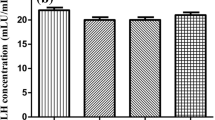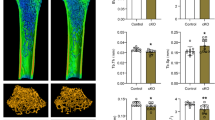Abstract
Homocysteine (Hcy) increases oxidation and inflammation; however, the mechanism of Hcy-induced bone fragility remains unclear. Because selective estrogen modulators (SERMs) have an anti-oxidative effect, SERMs may rescue the Hcy-induced bone fragility. We aimed to examine whether oxidative stress and pro-inflammatory cytokines such as interleukin (IL)-1β and IL-6 are involved in the Hcy-induced apoptosis of osteocytes and whether bazedoxifene (BZA) inhibits the detrimental effects of Hcy. We used mouse osteocyte-like cell lines MLO-Y4-A2 and Ocy454. Apoptosis was examined by DNA fragmentation ELISA and TUNEL staining, and gene expression was evaluated by real-time PCR. Hcy 5 mM significantly increased expressions of NADPH oxidase (Nox)1, Nox2, IL-1β, and IL-6 as well as apoptosis in MLO-Y4-A2 cells. Nox inhibitors, diphenyleneiodonium chloride and apocynin, significantly suppressed Hcy-induced IL-1β and IL-6 expressions. In contrast, an IL-1β receptor antagonist and an IL-6 receptor monoclonal antibody had no effects on Hcy-induced Nox1 and Nox2 expressions, but significantly rescued Hcy-induced apoptosis. BZA (1 nM–1 μM) and 17β estradiol 100 nM significantly rescued Hcy-induced apoptosis, while an estrogen receptor blocker ICI 182,780 reversed the effects of BZA and 17β estradiol. BZA also rescued Hcy-induced apoptosis of Ocy454 cell, and ICI canceled the effect of BZD. Moreover, BZA significantly ameliorated Hcy-induced expressions of Nox1, Nox2, IL-1β, and IL-6, and ICI canceled the effects of BZA on their expressions. Hcy increases apoptosis through stimulating Nox 1 and Nox 2-IL-1β and IL-6 expressions in osteocyte-like cells. BZA inhibits the detrimental effects of Hcy on osteocytes via estrogen receptor.








Similar content being viewed by others
Abbreviations
- Hcy:
-
Homocysteine
- BZA:
-
Bazedoxifene acetate
- Nox:
-
NADPH oxidase
- DM:
-
Diabetes mellitus
- T2DM:
-
Type 2 diabetes mellitus
- BMD:
-
Bone mineral density
- α-MEM:
-
α-minimum essential medium
- SERM:
-
Selective estrogen receptor modulators
- DPI:
-
Diphenyleneiodonium chloride
- Apo:
-
Apocinin
References
Johnell O, Kanis JA, Oden A, Sernbo I, Redlund-Johnell I, Petterson C, De Laet C, Jonsson B (2004) Mortality after osteoporotic fractures. Osteoporos Int 15:38–42
Selhub J, Jacques PF, Wilson PW, Rush D, Rosenberg IH (1993) Vitamin status and intake as primary determinants of homocysteinemia in an elderly population. JAMA 270:2693–2698
McLean RR, Jacques PF, Selhub J, Tucker KL, Samelson EJ, Broe KE, Hannan MT, Cupples LA, Kiel DP (2004) Homocysteine as a predictive factor for hip fracture in older persons. N Engl J Med 350:2042–2049
van Meurs JB, Dhonukshe-Rutten RA, Pluijm SM, van der Klift M, de Jonge R, Lindemans J, de Groot LC, Hofman A, Witteman JC, van Leeuwen JP, Breteler MM, Lips P, Pols HA, Uitterlinden AG (2004) Homocysteine levels and the risk of osteoporotic fracture. N Engl J Med 350:2033–2041
Yang J, Hu X, Zhang Q, Cao H, Wang J, Liu B (2012) Homocysteine level and risk of fracture: a meta-analysis and systematic review. Bone 51:376–382
Li J, Zhang H, Yan L, Xie M, Chen J (2014) Fracture is additionally attributed to hyperhomocysteinemia in men and premenopausal women with type 2 diabetes. J Diabetes Investig 5:236–241
Schwartz AV, Sellmeyer DE, Ensrud KE, Cauley JA, Tabor HK, Schreiner PJ, Jamal SA, Black DM, Cummings SR (2001) Older women with diabetes have an increased risk of fracture: a prospective study. J Clin Endocrinol Metab 86:32–38
Vestergaard P (2007) Discrepancies in bone mineral density and fracture risk in patients with type 1 and type 2 diabetes–a meta-analysis. Osteoporos Int 18:427–444
Yamamoto M, Yamaguchi T, Yamauchi M, Kaji H, Sugimoto T (2009) Diabetic patients have an increased risk of vertebral fractures independent of BMD or diabetic complications. J Bone Mineral Res 24:702–709
Kanani PM, Sinkey CA, Browning RL, Allaman M, Knapp HR, Haynes WG (1999) Role of oxidant stress in endothelial dysfunction produced by experimental hyperhomocyst(e)inemia in humans. Circulation 100:1161–1168
Hoogeveen EK, Kostense PJ, Beks PJ, Mackaay AJ, Jakobs C, Bouter LM, Heine RJ, Stehouwer CD (1998) Hyperhomocysteinemia is associated with an increased risk of cardiovascular disease, especially in non-insulin-dependent diabetes mellitus: a population-based study. Arterioscler Thromb Vasc Biol 18:133–138
Yun J, Kim JY, Kim OY, Jang Y, Chae JS, Kwak JH, Lim HH, Park HY, Lee SH, Lee JH (2011) Associations of plasma homocysteine level with brachial-ankle pulse wave velocity, LDL atherogenicity, and inflammation profile in healthy men. Nutr Metab Cardiovasc Dis NMCD 21:136–143
McCarty MF, O’Keefe JH, DiNicolantonio JJ (2017) Interleukin-1beta may act on hepatocytes to boost plasma homocysteine—the increased cardiovascular risk associated with elevated homocysteine may be mediated by this cytokine. Med Hypotheses 102:78–81
Takeno A, Kanazawa I, Tanaka K, Notsu M, Yokomoto M, Yamaguchi T, Sugimoto T (2015) Activation of AMP-activated protein kinase protects against homocysteine-induced apoptosis of osteocytic MLO-Y4 cells by regulating the expressions of NADPH oxidase 1 (Nox1) and Nox2. Bone 77:135–141
Kanazawa I, Tomita T, Miyazaki S, Ozawa E, Yamamoto LA, Sugimoto T (2017) Bazedoxifene ameliorates homocysteine-induced apoptosis and accumulation of advanced glycation end products by reducing oxidative stress in MC3T3-E1 cells. Calcif Tissue Int 100:286–297
Ellis AG, Reginster JY, Luo X, Bushmakin AG, Williams R, Sutradhar S, Mirkin S, Jansen JP (2014) Indirect comparison of bazedoxifene vs oral bisphosphonates for the prevention of vertebral fractures in postmenopausal osteoporotic women. Curr Med Res Opin 30:1617–1626
Nakamura T, Imai Y, Matsumoto T, Sato S, Takeuchi K, Igarashi K, Harada Y, Azuma Y, Krust A, Yamamoto Y, Nishina H, Takeda S, Takayanagi H, Metzger D, Kanno J, Takaoka K, Martin TJ, Chambon P, Kato S (2007) Estrogen prevents bone loss via estrogen receptor alpha and induction of Fas ligand in osteoclasts. Cell 130:811–823
Morita M, Sato Y, Iwasaki R, Kobayashi T, Watanabe R, Oike T, Miyamoto K, Toyama Y, Matsumoto M, Nakamura M, Kawana H, Nakagawa T, Miyamoto T (2016) Selective estrogen receptor modulators suppress hif1alpha protein accumulation in mouse osteoclasts. PLoS ONE 11:e0165922
Mann V, Huber C, Kogianni G, Collins F, Noble B (2007) The antioxidant effect of estrogen and Selective Estrogen Receptor Modulators in the inhibition of osteocyte apoptosis in vitro. Bone 40:674–684
van Essen HW, Holzmann PJ, Blankenstein MA, Lips P, Bravenboer N (2007) Effect of raloxifene treatment on osteocyte apoptosis in postmenopausal women. Calcif Tissue Int 81:183–190
Bellido T (2014) Osteocyte-driven bone remodeling. Calcif Tissue Int 94:25–34
Tomkinson A, Reeve J, Shaw RW, Noble BS (1997) The death of osteocytes via apoptosis accompanies estrogen withdrawal in human bone. J Clin Endocrinol Metab 82:3128–3135
Tomkinson A, Gevers EF, Wit JM, Reeve J, Noble BS (1998) The role of estrogen in the control of rat osteocyte apoptosis. J Bone Miner Res 13:1243–1250
Notsu M, Kanazawa I, Takeno A, Yokomoto-Umakoshi M, Tanaka KI, Yamaguchi T, Sugimoto T (2017) Advanced glycation end product 3 (AGE3) increases apoptosis and the expression of sclerostin by stimulating TGF-beta expression and secretion in osteocyte-like MLO-Y4-A2 cells. Calcif Tissue Int 100:402–411
Welshons WV, Wolf MF, Murphy CS, Jordan VC (1988) Estrogenic activity of phenol red. Mol Cell Endocrinol 57:169–178
Spatz JM, Wein MN, Gooi JH, Qu Y, Garr JL, Liu S, Barry KJ, Uda Y, Lai F, Dedic C, Balcells-Camps M, Kronenberg HM, Babij P, Pajevic PD (2015) The Wnt inhibitor sclerostin is up-regulated by mechanical unloading in osteocytes in vitro. J Biol Chem 290:16744–16758
Livak KJ, Schmittgen TD (2001) Analysis of relative gene expression data using real-time quantitative PCR and the 2(-Delta Delta C(T)) Method. Methods 25:402–408
Kanazawa I, Yamaguchi T, Yano S, Yamauchi M, Sugimoto T (2010) Fasudil hydrochloride induces osteoblastic differentiation of stromal cell lines, C3H10T1/2 and ST2, via bone morphogenetic protein-2 expression. Endocr J 57:415–421
Gori AM, Corsi AM, Fedi S, Gazzini A, Sofi F, Bartali B, Bandinelli S, Gensini GF, Abbate R, Ferrucci L (2005) A proinflammatory state is associated with hyperhomocysteinemia in the elderly. Am J Clin Nutr 82:335–341
Amarasekara DS, Yu J, Rho J (2015) Bone loss triggered by the cytokine network in inflammatory autoimmune diseases. J Immunol Res 2015:832127
Thaler R, Agsten M, Spitzer S, Paschalis EP, Karlic H, Klaushofer K, Varga F (2011) Homocysteine suppresses the expression of the collagen cross-linker lysyl oxidase involving IL-6, Fli1, and epigenetic DNA methylation. J Biol Chem 286:5578–5588
Zhang Y, He Y, Zong Y, Guo J, Sun L, Ma Y, Dong W, Gui L (2015) 17beta-estradiol attenuates homocysteine-induced oxidative stress and inflammatory response as well as MAPKs cascade via activating PI3-K/Akt signal transduction pathway in Raw 264.7 cells. Acta Biochim Biophys Sin 47:65–72
Arai M, Shibata Y, Pugdee K, Abiko Y, Ogata Y (2007) Effects of reactive oxygen species (ROS) on antioxidant system and osteoblastic differentiation in MC3T3-E1 cells. IUBMB Life 59:27–33
Saito M, Marumo K, Soshi S, Kida Y, Ushiku C, Shinohara A (2010) Raloxifene ameliorates detrimental enzymatic and nonenzymatic collagen cross-links and bone strength in rabbits with hyperhomocysteinemia. Osteoporos Int 21:655–666
Johnell O, Kanis JA, Black DM, Balogh A, Poor G, Sarkar S, Zhou C, Pavo I (2004) Associations between baseline risk factors and vertebral fracture risk in the Multiple Outcomes of Raloxifene Evaluation (MORE) Study. J Bone Miner Res 19:764–772
Andersson A, Bernardi AI, Stubelius A, Nurkkala-Karlsson M, Ohlsson C, Carlsten H, Islander U (2016) Selective oestrogen receptor modulators lasofoxifene and bazedoxifene inhibit joint inflammation and osteoporosis in ovariectomised mice with collagen-induced arthritis. Rheumatol (Oxf) 55:553–563
Gianni W, Ricci A, Gazzaniga P, Brama M, Pietropaolo M, Votano S, Patane F, Agliano AM, Spera G, Marigliano V, Ammendola S, Agnusdei D, Migliaccio S, Scandurra R (2004) Raloxifene modulates interleukin-6 and tumor necrosis factor-alpha synthesis in vivo: results from a pilot clinical study. J Clin Endocrinol Metab 89:6097–6099
Komm BS, Kharode YP, Bodine PV, Harris HA, Miller CP, Lyttle CR (2005) Bazedoxifene acetate: a selective estrogen receptor modulator with improved selectivity. Endocrinology 146:3999–4008
Jaber BM, Gao T, Huang L, Karmakar S, Smith CL (2006) The pure estrogen receptor antagonist ICI 182,780 promotes a novel interaction of estrogen receptor-alpha with the 3′,5′-cyclic adenosine monophosphate response element-binding protein-binding protein/p300 coactivators. Mol Endocrinol 20:2695–2710
Jover-Mengual T, Castello-Ruiz M, Burguete MC, Jorques M, Lopez-Morales MA, Aliena-Valero A, Jurado-Rodriguez A, Perez S, Centeno JM, Miranda FJ, Alborch E, Torregrosa G, Salom JB (2017) Molecular mechanisms mediating the neuroprotective role of the selective estrogen receptor modulator, bazedoxifene, in acute ischemic stroke: a comparative study with 17beta-estradiol. J Steroid Biochem Mol Biol 171:296–304
Acknowledgements
This study had funding support from Pfizer. Pfizer did not affect the study protocol, interpretation of the results, or discussion. Authors’ roles: MN and IK were responsible for designing and conducting the study. MN performed the experiments and analyzed the data. AT and KT contributed equipment/materials. MN and IK wrote the manuscript. TS reviewed and edited the manuscript. All authors approved the final version. IK takes responsibility for the integrity of the data analysis. The authors thank Keiko Nagira for technical assistance.
Funding
IK and TS have received lecture fees from Pfizer.
Author information
Authors and Affiliations
Corresponding author
Ethics declarations
Conflict of interest
Masakazu Notsu, Ippei Kanazawa, Ayumu Takeno, Ken-ichiro Tanaka, and Toshitsugu Sugimoto declare that they have no competing interests.
Human and Animal Rights
This article does not contain any studies with human participants or animals performed by any of the authors.
Additional information
Publisher's Note
Springer Nature remains neutral with regard to jurisdictional claims in published maps and institutional affiliations.
Rights and permissions
About this article
Cite this article
Notsu, M., Kanazawa, I., Takeno, A. et al. Bazedoxifene Ameliorates Homocysteine-Induced Apoptosis via NADPH Oxidase-Interleukin 1β and 6 Pathway in Osteocyte-like Cells. Calcif Tissue Int 105, 446–457 (2019). https://doi.org/10.1007/s00223-019-00580-7
Received:
Accepted:
Published:
Issue Date:
DOI: https://doi.org/10.1007/s00223-019-00580-7




